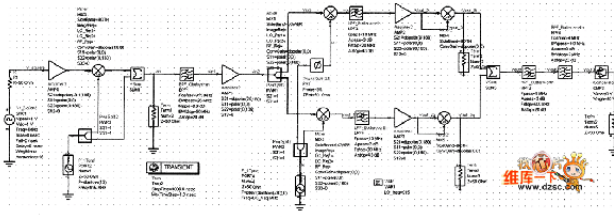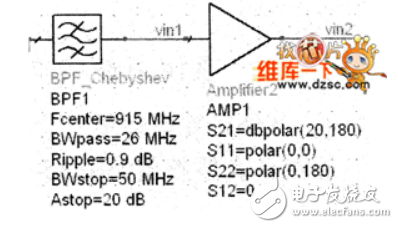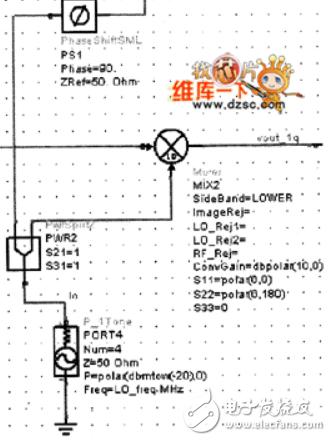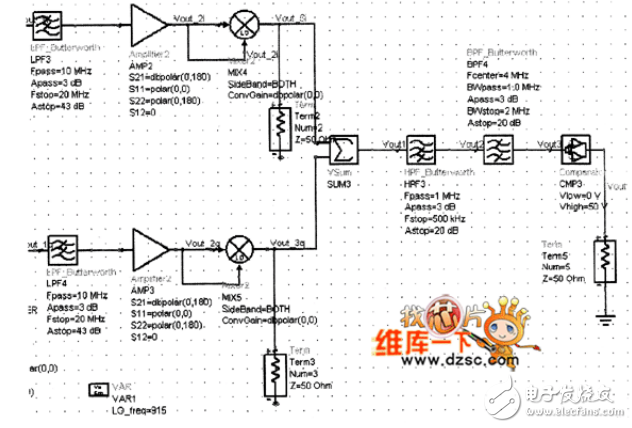System simulation schematic shown in Figure 1. Figure 1 ADS simulation principle of system RF interface (1) The front-end RF band-pass filter uses a fourth-order Chebyshev band-pass filter (BPF_Chebyshev) with a center frequency of Fcenter = 915MHz, a 3dB bandwidth of 26MHz, and a cut-off bandwidth of 50MHz. It is expected that -20dB of out-of-band attenuation can be obtained. . In addition, the passband ripple is 0.9dB and the insertion loss is 2.6dB, as shown in FIG. 2 . (2) The front-end amplifier LNA gain is 20dB, so set the Amplifier to S21=dbpolar(20,180). (1) Local oscillator: Select a voltage source in the Sources-Freq Domain palette. Figure 2 System RF front-end parameter settings Since the receiver IF is 0, the local oscillator frequency should be the same as the input signal frequency. This is set to the variable LO_freq, which can be used. The VAR is easily assigned and the output voltage power is set to -20 dBm, as shown in Figure 3. (2) Since the received signal is to be divided into two channels of the same phase and orthogonality, the local oscillator signal must also be divided into two channels. All channels are mixed directly with the received signal. All channels are first phase-shifted by 90° and then entered. Frequency mixers, so also use phase shifters and power dividers, all of which can be found in the System -Passive palette. (3) The mixer in the down-conversion section uses the behavioral mixer in the SySTem-Amps & Mixer palette. Be careful not to mistake Mixer2 because it is used for nonlinear analysis, and Mixer is used for frequency conversion. Set the mixer's sideband to LOWER with a gain of 10dB. Fig. 2 System RF front-end parameter settings Fig. 3 Mixer partial parameter settings Fig. 4 Analog baseband partial parameter setting The next part of the analog baseband is divided into two branches, each of which consists of a channel-selected low-pass filter, a baseband amplifier, and a cascade of self-massers, as shown in Figure 4. The channel selection low-pass filter uses an 8th-order Butterworth filter with a -3 dB frequency turning point of 10 MHz and a stopband cut-off point frequency of 20 MHz. It is expected to obtain 43 dB of adjacent channel attenuation. The high-pass filter is used to eliminate the DC component of the received baseband signal. The gain of the baseband amplifier is adjustable by the external resistor. Finally add the ports Term2 and Term3 to the baseband output Lithium Battery For Electric Transport Trolley
Battery For Electric Transport Trolley,Lithium Battery For Electric Trolley,Electric Golf Trolley Lithium Battery,Go Kart Golf Trolley Lithium Battery Shenzhen Zhifu New Energy Co., Ltd. , https://www.sunbeambattery.com



Why do Lithium batteries last longer than Lead-acid?
The nature of Lithium and the integrated Battery Management System (BMS), allow Lithium batteries to last five times longer than Lead-acid.
If you opened the casing (which we definitely don't recommend!), you would see that a Lithium battery consists of a number of individual power cells which are joined together to offer the required capacity (number of holes you can play). The Battery Management system is a really clever piece of kit (think of it as a mini computer), which performs a vital role in keeping the battery components safe, while allowing each power cell to discharge at an even rate. This system spreads the 'load' on the cells and reduces cell damage to maintain capacity for as long as possible.
Can I top-up my battery between rounds?
Another benefit of Lithium batteries is that they can take a 'top-up' charge. What does this mean? In practical terms, it means that it does not need a full charging cycle to 'top-up' the capacity (number of holes you can play). A common scenario would be a golfer who is playing 36 holes in a single day and decides to put their battery on charge between rounds. The capacity will be topped up for as long as the battery is on charge, which might come in VERY handy after a long and tiring day out on the links! This is very different from a traditional Lead-acid battery, which is only worth charging for a full cycle - that's a minimum of eight hours! In addition to this, a Lithium battery takes a speedy 4-5 hours to fully charge from empty - that's got to be good for your electricity bill!
Should I leave my battery on charge all the time?
No is the simple answer, because you really don't need to and it is always safer (plus greener) to leave appliances unplugged if possible!
Don't worry though - your Lithium battery and its dedicated charger are designed to 'switch off' once fully-charged to reduce the risk of continual charging and the potential for overheating. We therefore recommend waiting for the charger light to change from red to green, before switching off at the wall and unplugging the battery from the charger. This doesn't damage the battery and the battery will hold its charge until you next play.
1. System Simulation Schematic